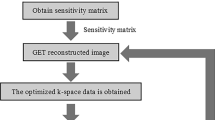Abstract
Purpose
GRAPPA is a well-known parallel imaging method that recovers the MR magnitude image from aliasing by using a weighted interpolation of the data in k-space. To estimate the optimal reconstruction weights, GRAPPA uses a band along the center of the k-space where the signal is sampled at the Nyquist rate, the so-called autocalibrated (ACS) lines. However, while the subsampled lines usually belong to the medium- to high-frequency areas of the spectrum, the ACS lines include the low-frequency areas around the DC component. The use for estimation and reconstruction of areas of the k-space with very different features may negatively affect the final reconstruction quality. We propose a simple, yet powerful method to eliminate reconstruction artifacts, based on the discrimination of the low-frequency spectrum.
Methods
The proposal to improve the estimation of the weights lays on a proper selection of the coefficients within the ACS lines, which advises discarding those points around the DC component. A simple approach is the elimination of a square window in the center of the k-space, although more developed approaches can be used.
Results
The method is tested using real multiple-coil MRI acquisitions. We empirically show this approach achieves great enhancement rates, while keeping the same complexity of the original GRAPPA and reducing the g-factor. The reconstruction is even more accurate when combined with other reconstruction methods. Improvement rates of 35 % are achieved for 32 ACS and acceleration rate of 3.
Conclusions
The method proposed highly improves the accuracy of the GRAPPA coefficients and therefore the final image reconstruction. The method is fully compatible with the original GRAPPA formulation and with other optimization methods proposed in literature, and it can be easily implemented into the commercial scanning software.











Similar content being viewed by others
References
Blaimer M, Breuer F, Mueller M, Heidemann R, Griswold M, Jakob P (2004) SMASH, SENSE, PILS, GRAPPA: how to choose the optimal method. Top Magn Reson Imaging 15(4):223–236
Breuer FA, Kannengiesser SA, Blaimer M, Seiberlich N, Jakob PM, Griswold MA (2009) General formulation for quantitative g-factor calculation in GRAPPA reconstructions. Magn Reson Med 62(3):739–746
Chang Y, Liang D, Ying L (2012) Nonlinear GRAPPA: a kernel approach to parallel MRI reconstruction. Magn Reson Med 68(3):730–740
Chen Z, Zhang J, Yang R, Kellman P, Johnston LA, Egan GF (2010) IIR GRAPPA for parallel MR image reconstruction. Magn Reson Med 63(2):502–509
Constantinides C, Atalar E, McVeigh E (1997) Signal-to-noise measurements in magnitude images from NMR phased arrays. Magn Reson Med 38:852–857
Ding Y, Xue H, Ahmad R, Chang Tc, Ting ST, Simonetti OP (2014) Paradoxical effect of the signal-to-noise ratio of GRAPPA calibration lines: a quantitative study. Magn Reson Med. doi:10.1002/mrm.25385
Eskicioglu A, Fisher P (1995) Image quality measures and their performance. IEEE Trans Commun 43(12):2959–2965
Griswold MA, Jakob PM, Heidemann RM, Nittka M, Jellus V, Wang J, Kiefer B, Haase A (2002) Generalized autocalibrating partially parallel acquisitions (GRAPPA). Magn Reson Med 47(6):1202–1210
Hoge WS, Brooks DH, Madore B, Kyriakos WE (2005) A tour of accelerated parallel MR imaging from a linear systems perspective. Concepts Magn Reson Part A 27A(1):17–37
Huang F, Li Y, Vijayakumar S, Hertel S, Duensing GR (2008) High-pass GRAPPA: an image support reduction technique for improved partially parallel imaging. Magn Reson Med 59(3):642–649
Huo D, Wilson D (2008) Robust GRAPPA reconstruction and its evaluation with the perceptual difference model. J Magn Reson 27(6):1412–1420
Ji JX, Son JB, Rane SD (2007) PULSAR: a matlab toolbox for parallel magnetic resonance imaging using array coils and multiple channel receivers. Concepts in Magn Reson Part B Magn Reson Eng 31B(1):24–36
Lim JS (1990) Two dimensional signal and image processing. Prentice Hall, Englewood Cliffs
Park S, Park J (2012) Adaptive self-calibrating iterative GRAPPA reconstruction. Magn Reson Med 67(6):1721–1729
Wang H, Liang D, King KF, Nagarsekar G, Chang Y, Ying L (2012) Improving GRAPPA using cross-sampled autocalibration data. Magn Reson Med 67(4):1042–1053
Wang Z, Bovik AC, Sheikh HR, Simoncelli EP (2004) Image quality assessment: from error visibility to structural similarity. IEEE Trans Image Process 13(4):600–612
Wu C, Hu W, Kan R, Yu J, Sun X (2011) An improved GRAPPA image reconstruction algorithm for parallel MRI. In: Control and decision conference (CCDC), 2011 Chinese, pp 4096–4100
Acknowledgments
The authors acknowledge Ministerio de Ciencia e Innovación for grant TEC2013-44194, Institute of Health Carlos III for grant PI11-0149 and Centro de Técnicas Instrumentales, Universidad de Valladolid for MRI acquisitions. Gonzalo Vegas-Sánchez-Ferrero acknowledges Consejería de Educación, Juventud y Deporte of Comunidad de Madrid and the People Programme (Marie Curie Actions) of the European Union’s Seventh Framework Programme (FP7/2007–2013) for REA grant agreement no. 291820.
Conflict of interest
The authors declare that they have no conflict of interest in relation to this article.
Author information
Authors and Affiliations
Corresponding author
Rights and permissions
About this article
Cite this article
Aja-Fernández, S., Martín, D.G., Tristán-Vega, A. et al. Improving GRAPPA reconstruction by frequency discrimination in the ACS lines. Int J CARS 10, 1699–1710 (2015). https://doi.org/10.1007/s11548-015-1172-7
Received:
Accepted:
Published:
Issue Date:
DOI: https://doi.org/10.1007/s11548-015-1172-7




